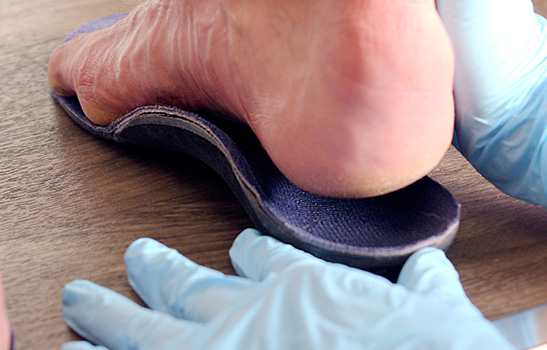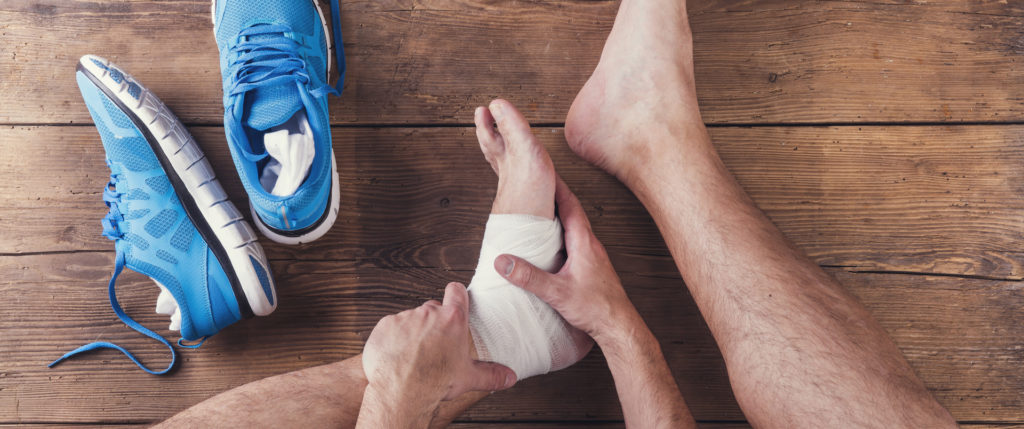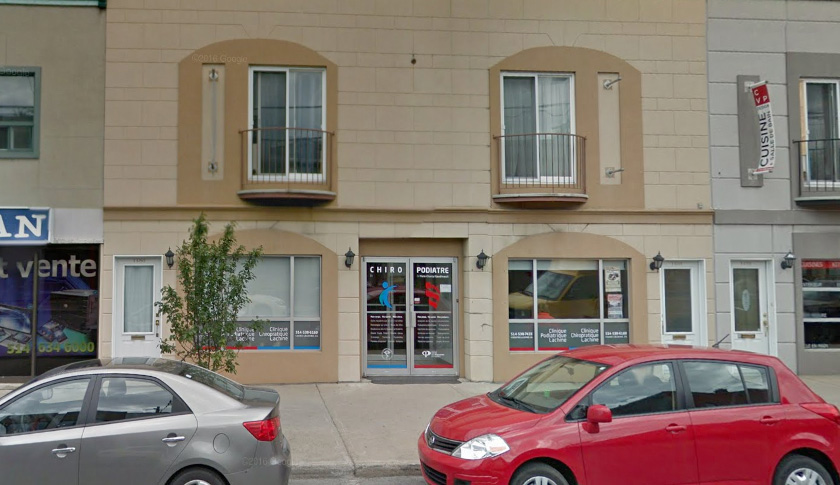Metatarsalgia
Metatars- algia
“Metatars-”: Refers to the metatarsal bones, the long bones in the ball of the foot that attach to the toes. “-algia”: From the Greek álgos, meaning pain.
Metatarsalgia is a general term used to denote pain originating in the ball of the foot, more precisely at the ends of the metatarsal bones. The condition may affect one or multiple bones but is most commonly found at the base of the second toe. The term “metatarsalgia” encompasses a number of potential diagnoses including capsulitis, bursitis, partial or complete tear of the plantar plate, tendinitis/tenosynovitis of the flexor tendons or panniculitis. The pain associated with this condition arises more often from the soft tissues surrounding the metatarsal bone rather than the bone itself.
See the causes See the long term complications See how to relieve yourself at home
Signs and symptoms of a metatarsalgia
- Sensation of a lump under the foot
- Pain under the sole or ball of the foot
- Pain at the base of the toes
- Burning sensation
- Toe cramps
- The pain may be localized or radiate over the entire forefoot region
- Electric shocks or numbness sensation in the toes
- Pain worsens when wearing high-heel shoes or thin soles
- Pain worsens with physical activity
- Feels like a part of your sock is crumpled inside your shoe
- Twisting, shifting or deviated toes (hammer toes)
- Accumulation of calluses under the bones of the forefoot
- In rare cases, swelling and redness at the base of the toes
- Sharp pain may also be felt during rest
What are the causes of a metatarsalgia
The metatarsal bones articulate with the toes to support our weight and propel us forward when we walk or run. To help these small structures sustain the entire weight of our bodies, a number of supporting and stabilizing structures need to come into play. These include : a fat pad, muscles and tendons, a cushioning structure called bursae, the joint capsule, several ligament attachments including the plantar plate, a fibrocartilaginous structure. The plantar plate in particular acts as a cushion that allows the toe to bend and extend with ease. A number of gait disturbances can lead to the overloading and/or impingement of these structures.
Here are some of the foot-related biomechanical problems that can put excessive pressure on the stabilizing structures of the toes:
- Problems with metatarsal length (short/long first metatarsal or excessively long second metatarsal for example)
- Bunions (HAV)
- Loss of motion in the big toe joint (hallux limitus) and/or arthrosis of the big toe
- Flat feet or fallen arches (hyperpronation)
- High arches
- Leg-length discrepancy
- Forefoot valgus/varus
- Joint hypermobility resulting in the spreading of the metatarsal bones
- Lack of flexibility in the calf muscles
- Poor ankle mobility (blockage or arthrosis)
There are also aggravating factors that can make the problem worse :
- Unsuitable footwear (narrow-fitting shoes, thin soles, high heels)
- Repeated excessive stress (running, jumping, high-impact sports, etc.)
- Poor work posture (with the toes hyperextended)
- Being overweight
- Poor running technique
- Improper exercise technique
- Inappropriate training program
- Modified gait due to surgery or injury
Progression and consequences of a metatarsalgia
The longer the stress to the metatarsal region persists and the more intense it gets, the more the stabilizing structures get damaged and the less they’re able to support the toe. This is what can cause the toe to curve and irreversibly develop a hammertoe.
Ultimately, a number of structures such as the plantar plate may suffer a partial or complete tear. At this stage, there is a risk of complete dislocation of the toe and this is why the condition can be known as “predislocation syndrome”.
In addition, when a toe’s supporting structures are weakened, the other metatarsal bones attempt to compensate and come to bear excessive loads. Pain and problems can then develop in these areas.
Finally, having pain around one or multiple metatarsal bones can lead to unconscious changes in gait, which can have a domino effect on the entire body, causing pain elsewhere in the foot, at the ankles or knees or even in the back.
How to relieve the pain of a metatarsalgia at home
1. Rest and relief :
- Wear laced shoes with thick, cushioning insoles and a slight heel (e.g., running shoes) as often as possible, even at home.
- Fit shoes with pharmacy-bought cushioning insoles.
- Reduce activities that require a lot of walking.
- Choose sports that are less taxing on the feet such as cycling or swimming.
2. Managing the inflammation :
- In the initial stage, apply ice directly to the painful area 10-15 minutes every hour. A good tip is to place a frozen water bottle on the floor and massage your forefoot by rolling it over the bottle.
- Take appropriate doses of anti-inflammatory drugs like Advil or Aleve if your health condition allows it.
3. Self-massage :
- Perform a massage by rolling a golf or tennis ball under your foot, being careful not to apply direct pressure to the painful area. This helps relax the muscles in the foot that become overworked supporting the toes.
- Pull gently on the affected toe, then carefully raise and lower the toe to help reduce the tension in the surrounding structures.
Diagnostic of a metatarsalgia
Because any number of different structures may be affected, it’s important to carry out a comprehensive evaluation to identify the exact site of injury. There are three steps to this evaluation:
- To identify the problem region, evaluate foot function and identify whether poor foot alignment or posture may be at fault, a thorough biomechanical exam is essential. The exam is accompanied by a computerized gait analysis performed using pressure sensors. This technology lets us evaluate the distribution of plantar pressure and identify areas of the foot that are overtaxed
- X-rays must be conducted to assess bone and joint integrity in the problem region and to check for calcium deposits, arthrosis and bone spurs. X-rays also make it possible to rule out other diagnoses.
- Ultrasound is an excellent imaging technique and diagnostic tool. It allows the podiatrist to observe all the structures surrounding the joint, including the tendons, ligaments, plantar plate and joint capsule. Ultrasound also makes it possible to assess the severity of the condition and check for the presence of tears.
What can my podiatrist do about a metatarsalgia
Once the affected structure and the potential causes have been identified, your podiatrist will be able to recommend a personalized treatment plan for your condition.
Some solutions include:
1. Plantar orthotics :
Plantar orthotics are essential when dealing with poor distribution of plantar pressure. These devices are designed to reduce the impact of mechanical problems on the function of the feet. They also ensure that uniform pressure is applied. Plantar orthotics protect the painful metatarsal, accelerate the healing of the weakened structures and help prevent a recurrence of the same problem.
2. Prescription medication :
Painkillers, muscle relaxants and/or anti-inflammatory drugs may be prescribed.
3. Radial shockwave therapy :
Used in chronic cases where patients fail to respond to treatment, this therapy uses the body’s natural capacities to restart the healing cycle, a bit like a time machine. Find out more about the radial shockwave therapy.
4. Manipulative therapy :
The podiatrist may perform manipulative therapy to mobilize sensitive joints and release the associated muscles and structures in order to reduce symptoms and promote healing.
5. Physical therapy :
- Cryotherapy and ultrasound
- Taping
- Splints, rocker bottom shoes and walker boots
6. Ultrasound-guided cortisone injections :
In some cases, metatarsalgia may be treated with cortisone injections. Instead of administering an anti-inflammatory drug in pill form, cortisone (an anti-inflammatory medication) is injected directly into the problem area. Ultrasound helps guide the injection process in real time, making it more precise and effective. Find out more.
How to prevent a metatarsalgia
- Wear appropriate footwear. Shoes should be wide enough and have a slight heel. Avoid shoes with thin soles.
- Replace your shoes and work boots annually.
- Wear your prescribed orthotics daily.
- If overweight, consider losing weight.
- Pay attention to your work posture and frequently change positions. Avoid sitting for long periods in slouched positions where you hyperextend your toes.
- Follow a progressive workout plan, particularly if you run.
- Run on a variety of surfaces (grass, dirt track, etc.).
- Replace running shoes if they wear down or after each 800-1,000 km of use. If your shoes are more lightweight or if you have a larger body mass, you may need to replace your shoes after 500-700 km.
The lump I feel underneath my foot must be a callus or a foreign body.

Many patients who suffer from metatarsalgia complain of a sensation of walking on a lump. However, no actual bump is present underneath the foot. Rather, the lump sensation is caused when the weight of the body presses down on the bottom part of the swollen metatarsal, therefore it feels like we are walking on a “sore bump”.
And if it was not a metatarsalgia?
- Morton’s neuroma
- Bursitis
- Metatarsal stress fracture
- Sesamoiditis
- Osteoarthritis
- Cyst
- Inflammatory arthritis (gout, rheumatoid arthritis, psoriatic arthritis, etc.)
- Plantar fasciitis
- Tumour mass
- Corns and calluses
- Reflex algodystrophy
- Radiculopathy (sciatic nerve or lumbar compression)
- Tarsal tunnel syndrome


